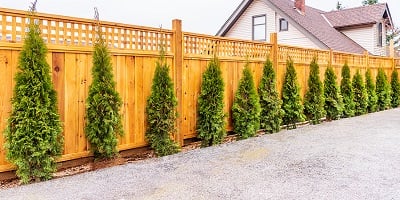Backyard season is here, and as Americans move to spend more time outdoors now is the perfect time to begin promoting fence installation and restoration to your customers. Both traditional wooden fences and vinyl fences, if properly maintained, can give a home a classic American Dream look, but there are pros and cons to each. Read on to learn more about what your customers should consider when deciding what kind of fence works best for their yard.
Appearance
If your customers are hoping to add their own unique style to a backyard space, a wooden fence may offer them the flexibility they’re hoping for. Customers who opt for a wooden fence have an almost endless number of options they can choose from. Wood used in privacy fences, picket fences, post and rail fences, and more can be left in its natural state or it can be stained or painted to match any style a customer might want. Ultimately, a wooden fence cannot be beat if a customer is going for a traditional feel.
On the other hand, vinyl fencing has come a long way since it was popularized in the 1980s. Just as with wooden fences, it can come in a variety of shapes and colors, but even with improved plastic compensation, wood will always look more natural.
Cost
Wooden fencing will typically cost about $12 per linear foot, not including the cost of installation and required maintenance. Alternatively, vinyl fencing will typically cost about $17 per linear foot, before installation. Customers who are budget-conscious may be tempted to opt for the cheaper wooden option; however, the cost of maintaining a wooden fence can result in the long-term costs of a wooden fence being comparable to those of a vinyl fence. As a result, deciding on build material is not as simple as choosing the cheapest option. Your customer should consider the long-term maintenance needs of both types of material.
Maintenance
Keep in mind that wooden fences require more maintenance than vinyl fences. As wood is exposed to the elements, it may warp or even rot. Luckily, wooden fences are relatively easy to repair as individual boards can be replaced as needed. Additionally, a wooden fence can be painted or stained a different color, allowing a customer to refresh the look of their yard without installing a new fence.
Vinyl fencing is more durable and needs less maintenance over the course of its life, other than to be cleaned periodically with a garden hose or pressure washer. Unfortunately, repairing a vinyl fence that has been damaged can be significantly more difficult, and sometimes it’s simply easier to replace the whole panel.
Building the perfect fence with BECK
Once you’ve chosen between a vinyl or wood fence, make sure you take the time to properly plan your build and purchase durable materials. To ensure your desired fence lasts for years to come, you’ll want to use high-quality products, like SCRAIL® Fasteners developed by BECK. SCRAIL® fasteners work with both vinyl and wood, and not only do they have incredible holding power, but they are removeable and adjustable. Those two features will save you headaches if you need to make adjustments, which often happen when building a fence to accommodate changes in ground height and landscaping. They come in exterior FasCoat® coating as well as 304 and 316 grade stainless steel making them perfect for outside jobs. As if that isn’t reason enough, if you use SCRAIL® Fasteners, they will help you complete your fence faster since they are two times faster than collated screws and eight times faster than bulk screws. To see how it works for yourself, check out this video.
.svg.png)


